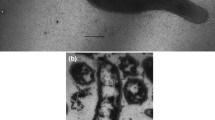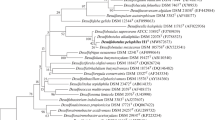Abstract
A new type of gas-vacuolated, sulfate-reducing bacterium was isolated at 10° C from reduced mud (E0 < 0) obtained from a temperate estuary with thiosulfate and lactate as substrates. The strain was moderately psychrophilic with optimum growth at 18–19° C and a maximum growth temperature of 24° C. Propionate, lactate, and alcohols served as electron donors and carbon sources. The organism grew heterotrophically only with hydrogen as electron donor. Propionate and lactate were incompletely oxidized to acetate; traces of lactate were fermented to propionate, CO2, and possibly acetate in the presence of sulfate. Pyruvate was utilized both with and without an electron acceptor present. The strain did not contain desulfoviridin. The G+C content was 48.4 mol%. The differences in the 16S rRNA sequence of the isolate compared with that of its closest phylogenetic neighbors, bacteria of the genus Desulfobulbus, support the assignment of the isolate to a new genus. The isolate is described as the type strain of the new species and genus, Desulforhopalus vacuolatus.
Similar content being viewed by others
Author information
Authors and Affiliations
Additional information
Received: 4 March 1996 / Accepted: 17 June 1996
Rights and permissions
About this article
Cite this article
Isaksen, M., Teske, A. Desulforhopalus vacuolatus gen. nov., sp. nov., a new moderately psychrophilic sulfate-reducing bacterium with gas vacuoles isolated from a temperate estuary. Arch Microbiol 166, 160–168 (1996). https://doi.org/10.1007/s002030050371
Issue Date:
DOI: https://doi.org/10.1007/s002030050371




